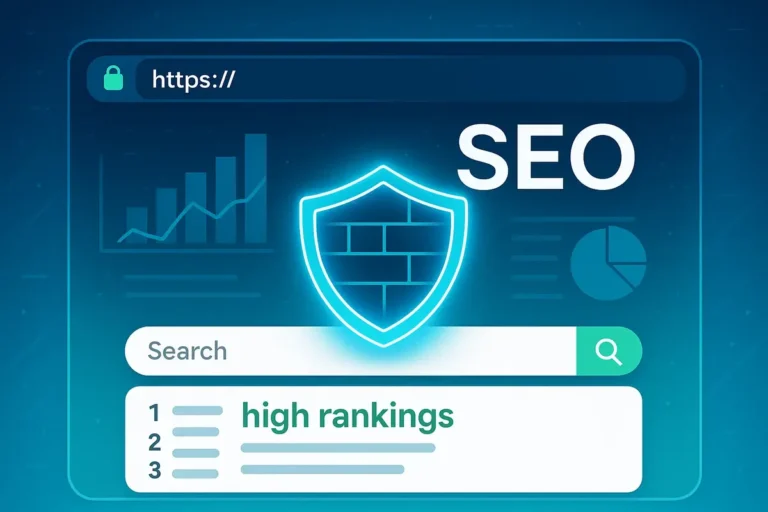Secure Website SEO: 2025–2026 Optimization Guide
In the fast-paced digital world of 2025 and beyond, websites that rank high on Google aren’t just fast and content-rich—they’re secure. If your site isn’t built like a digital fortress, even the best SEO strategy can crumble under the weight of a cyberattack or Google penalty. This guide will show you how secure website SEO is the hidden backbone of ranking success between 2025 and 2026.
Table of Contents
How to Master Secure Website SEO in 2025–2026
Why Secure Website SEO Matters More Than Ever
Google has evolved. It’s no longer just about keywords and backlinks—now, user safety and trust play a major role in search rankings. Sites that lack HTTPS encryption, contain malware, or are vulnerable to hacks face steep penalties.
From 2025 to 2026, expect even stricter search engine policies prioritizing user data protection. If your site isn’t secure, you’re not just losing traffic—you’re risking reputation, visibility, and long-term growth.
Step 1: Move to HTTPS (If You Haven’t Already)
HTTPS is no longer optional—it’s a requirement. If you’re still using HTTP in 2025, Google is actively warning visitors against your site.
- Get an SSL certificate (many hosts offer free Let’s Encrypt SSL)
- Force HTTPS redirects sitewide
- Update all internal links to HTTPS
A site with HTTPS tells users: “Your data is safe here.” That trust leads to better engagement, lower bounce rates, and higher rankings.
Step 2: Lock Down Your Backend
Cybercriminals in 2025 are more sophisticated than ever. Protect your admin panel and databases with:
- Two-Factor Authentication (2FA)
- Complex, unique passwords (use a manager like Bitwarden or 1Password)
- Limited user permissions
- Regular plugin and CMS updates
Website hacks are one of the leading causes of sudden drops in SEO rankings. Don’t let that be you.
Step 3: Keep a Clean Codebase
Googlebot doesn’t just scan your visible content—it looks at your source code too. A messy or infected codebase can get you penalized or blacklisted.
- Remove unused plugins or scripts
- Scan regularly for malware
- Avoid bloated themes and page builders
- Use tools like Sucuri or Wordfence for real-time monitoring
Remember, secure website SEO is also about maintaining technical health.
Step 4: Use a Web Application Firewall (WAF)
A WAF filters malicious traffic before it hits your server. This includes:
- DDoS attacks
- SQL injection attempts
- Cross-site scripting (XSS)
Platforms like Cloudflare and Sucuri offer WAFs that are easy to integrate and highly effective. Search engines favor sites that load quickly and stay online without security disruptions.
Step 5: Monitor Everything (Yes, Everything)
You can’t fix what you don’t see. Real-time monitoring is a key aspect of SEO protection:
- Use Google Search Console to track indexing issues
- Set up alerts for suspicious login attempts or code changes
- Review server logs weekly for anomalies
The earlier you catch issues, the less they impact your search visibility.
Step 6: Optimize for Mobile AND Secure It
Most web traffic in 2025–2026 is mobile. Ensure your mobile site:
- Loads over HTTPS
- Uses secure forms and input fields
- Isn’t vulnerable to mobile-specific attacks (e.g., cross-app scripting)
A secure mobile experience is now part of core web vitals—and core SEO success.
Bonus Tip: Security Messaging Builds User Trust
When users see trust signals like HTTPS, secure payment badges, or firewall protection notices, they stay longer.
Lower bounce rates = higher SEO rankings.
Your secure website SEO strategy should include visible proof of protection—because Google isn’t the only one watching. Your visitors care, too.
Final Thoughts
From 2025 to 2026, the winning SEO strategy isn’t just about keywords or backlinks. It’s about building and maintaining a secure, trustworthy web presence.
Secure website SEO is not just a tech checklist—it’s a long-term investment in your brand’s credibility, Google visibility, and visitor loyalty.
Start now. Rank better. Stay protected.
FAQ: Secure Website SEO 2025–2026
Is HTTPS still important for SEO in 2025?
Absolutely. HTTPS is a key trust signal for both users and Google. Without it, your site may trigger browser warnings and lose ranking power. It’s the foundation of secure website SEO.
Can a hacked site lose all its rankings?
Yes. A single hack can get your site blacklisted, deindexed, or flooded with spam pages. That can destroy months or years of SEO work overnight. Secure website SEO protects your visibility.
Do all CMS platforms support secure website SEO?
Most modern CMS platforms (WordPress, Joomla, Shopify…) fully support secure website SEO. But you must configure plugins, updates, and firewalls properly. It’s not automatic—it’s strategic.
How often should I scan for malware?
Weekly scans are essential, and daily is ideal for high-traffic or e-commerce sites. Automated tools can help you stay ahead of threats. Monitoring is a pillar of secure website SEO.
Is a security plugin enough?
Not really. A plugin is just one layer—true secure website SEO also includes a firewall, regular updates, strong credentials, and server-side monitoring. Think in layers, not shortcuts.
Does Google penalize insecure sites?
Yes. Sites marked as “Not Secure” or infected with malware can drop drastically in rankings. Google wants users to feel safe. Insecure = untrustworthy in Google’s eyes.
What is the best security plugin for WordPress?
Top choices include Wordfence, Sucuri, and iThemes Security. These tools offer malware scanning, firewall protection, and login security. Choose one, configure it well, and update regularly.
Should mobile SEO include security?
Definitely. Mobile users submit forms, make purchases, and log in—just like desktop users. Google expects mobile security too. A secure mobile experience is part of modern SEO.
What if I don’t handle sensitive data?
Hackers don’t care. Even simple blogs get targeted to inject spam, steal SEO juice, or redirect traffic. Every site needs protection. Secure website SEO applies to all web property types.
What’s the first step to take today?
Start with the basics: install an SSL certificate, update your CMS/plugins, and activate a firewall. These 3 steps lay the groundwork for secure website SEO success in 2025–2026.







